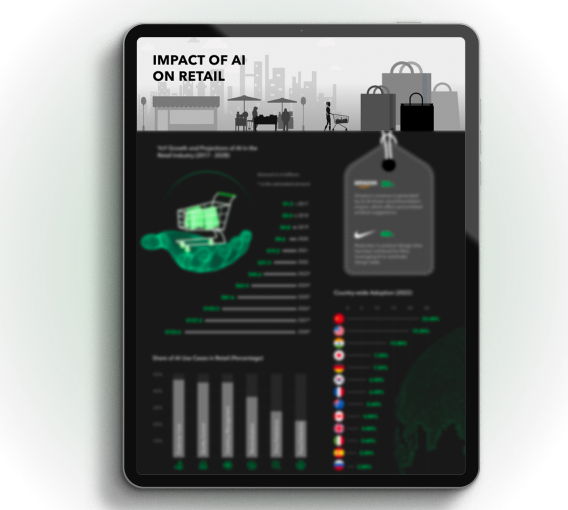- AI
- 24 min read
- February 2024
AI Use Cases in Retail Industry
Key Takeaways
The retail industry is increasingly embracing AI! Over 60% of retail respondents plan to increase their AI infrastructure investment in the next 18 months. A KPMG study shows that 90% of retail business leaders believe their employees are prepared and have the skills for AI adoption.
The key drivers for this adoption include store analytics, personalized recommendations, adaptive advertising, and demand forecasting.

Retail business leaders expect AI to have its biggest impact on customer intelligence, inventory management, and chatbots for customer service in the next two years.
However, there are challenges to overcome. These range from budget constraints to recruiting and retaining AI experts and data scientists.
There are also concerns about the speed of AI adoption, with 49% of retail business leaders believing AI adoption is moving faster than it should in their industry.
Cybersecurity breaches (47%) and possible AI bias (45%) are the top two greatest potential risks of AI adoption.
Despite these challenges, the industry is optimistic about the transformative potential of generative AI.
The value of AI in the retail market skyrocketed to an estimated 7.1 billion USD in 2023, indicating its significant impact on the sector.
**Please note that these insights are based on various reports and surveys, and the actual state of AI in retail may vary across different regions and retail sectors.
What is artificial intelligence in the retail industry?
The role of AI in transforming retail in a constantly evolving digital era is pivotal for shaping the future of retail operations and customer engagement. By leveraging AI technologies, retail businesses are poised to
- transform their operational efficiency
- personalize customer experiences
- harness data insights like never before
Exploration of AI technologies in retail
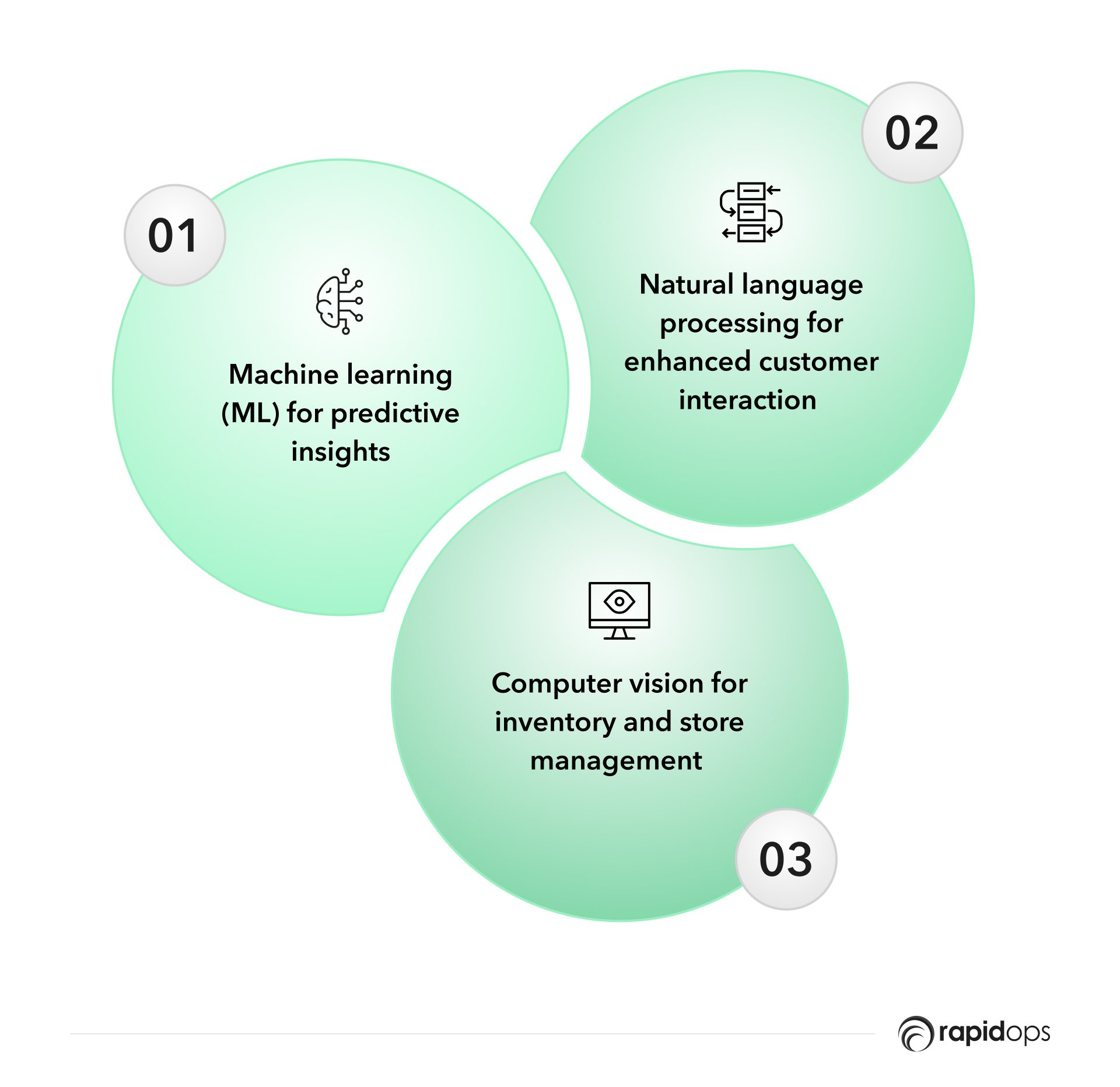
The retail industry is adopting Artificial Intelligence (AI) to meet and exceed consumers' evolving demands. At the heart of this transformation are three key technologies, and each plays a pivotal role in reshaping how retailers operate and engage with their customers.
1. Machine learning (ML) for predictive insights
ML is a cornerstone of AI in retail, offering unprecedented capabilities in understanding customer behavior, demand forecasting, and personalized marketing.
Machine learning algorithms can predict future buying habits, tailor product recommendations, and optimize inventory levels by analyzing vast customer data, from purchase history to online browsing patterns.
This predictive power enables retailers to stay ahead of consumer demand, ensuring that the right products are available at the right time, thereby enhancing customer satisfaction and loyalty.
2. Natural language processing for enhanced customer interaction
NLP transforms customer interactions by enabling more natural and intuitive communication between shoppers and AI systems.
From chatbots that provide instant customer service to voice-activated virtual shopping assistants, NLP allows customers to interact with technology in human-like ways.
This capability improves the shopping experience and offers retailers valuable insights into customer preferences and feedback, which can be used to refine product offerings and services further.
3. Computer vision for inventory and store management
Computer vision technology revolutionizes inventory management and in-store experiences.
Through AI-powered cameras and sensors, retailers can monitor inventory levels in real-time, detect out-of-stock situations, and even track customer movements within the store.
This technology supports automated management, loss prevention, and personalized in-store marketing, creating a seamless shopping experience for customers while providing retailers with critical data to improve store operations and layout.
Learn more about how these technologies are being used to revolutionize retail on our retail industry page.
Addressing retail needs with AI
By harnessing the power of machine learning, NLP, and computer vision, retailers can achieve greater operational efficiency, drive sales, and build stronger relationships with their customers.
Machine learning optimizes demand forecasting and management of inventory, reducing stockouts and overstock situations. NLP improves customer service and engagement, making interactions more natural and responsive.
Computer vision enhances inventory accuracy and shopper insights, leading to better store management and customer satisfaction.
Together, these technologies form a robust foundation for retailers to navigate the challenges of the modern retail environment and capitalize on new opportunities to drive growth and innovation.
AI use cases in the retail industry
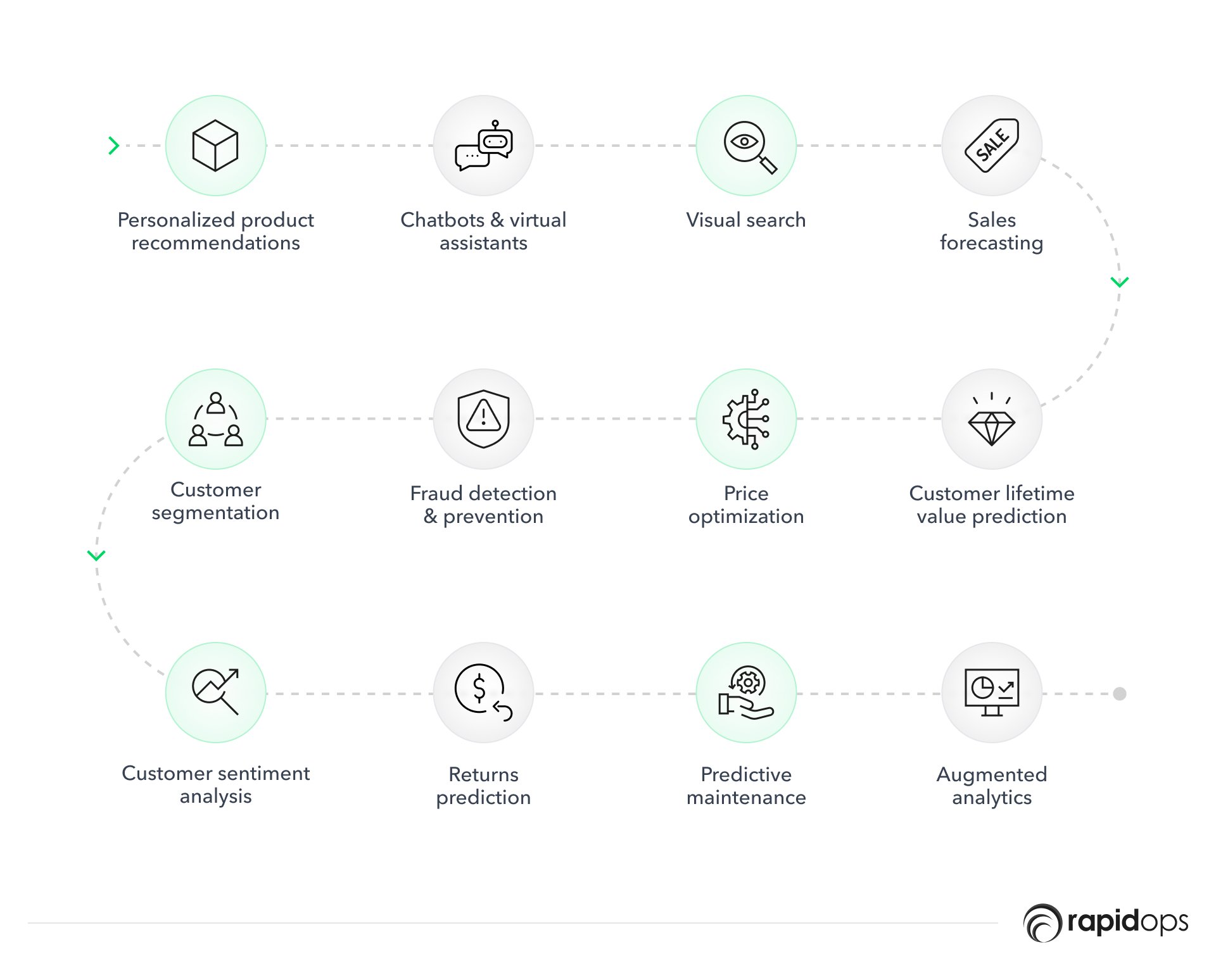
Thanks to artificial intelligence (AI) integration, the retail industry is witnessing a paradigm shift. This technology is automating mundane tasks and reshaping retail operations, customer interactions, and business models. Below, we explore significant AI use cases in retail, highlighting their impact and benefits.
1. Personalized product recommendations
AI systems analyze customer data, such as purchase history, browsing behavior, and preferences, to offer personalized product recommendations.
This enhances the shopping experience by making it more relevant and engaging. By closely aligning offerings with individual customer needs, it also increases sales and customer loyalty.
2. Chatbots and virtual assistants
Retailers leverage AI-powered chatbots and virtual assistants to provide round-the-clock customer service, handle inquiries, offer product recommendations, and assist with purchases.
These tools significantly improve customer engagement and operational efficiency by automating customer support and freeing human resources for more complex tasks.
3. Visual search
Visual search technology allows customers to upload images and find similar or related products in the retailer's inventory. This innovative approach simplifies the product discovery process.
It is particularly beneficial for customers who may not have the exact words to describe what they're looking for, thereby improving user experience and potentially increasing sales.
4. Sales forecasting
AI enhances sales forecasting by analyzing vast amounts of data to predict future sales trends.
Having such a capability allows retailers to
- optimize inventory levels
- reduce stockouts or overstocking
- make data-driven decisions regarding promotions and pricing strategies
- improve profitability and customer satisfaction
5. Customer segmentation
By employing machine learning algorithms to analyze customer behavior and demographic data, retailers can segment their customer base into distinct groups.
This segmentation enables targeted marketing efforts, personalized product offerings, personalized experiences, and tailored promotions, significantly increasing marketing effectiveness and customer engagement.
6. Fraud detection and prevention
AI systems are adept at identifying patterns and anomalies in transaction data that may indicate fraudulent activity.
By implementing AI-driven fraud detection, retailers can enhance security, reduce losses due to fraud, and build trust with their shoppers.
7. Price optimization
Retailers use AI to adjust prices based on demand, competition, and inventory levels.
This strategic approach to pricing helps maximize profits while ensuring prices remain competitive and attractive to customers.
8. Customer lifetime value prediction
Understanding the potential value of a customer over their lifetime with the brand allows retailers to tailor marketing strategies, customer service, and loyalty programs.
AI models predict customer lifetime value, enabling businesses to focus resources on high-value shoppers and personalize interactions to enhance loyalty and retention.
9. Customer sentiment analysis
AI-powered sentiment analysis tools evaluate customer feedback, reviews, and social media comments to gauge overall sentiment toward the brand, products, or services.
This insight helps retailers address issues, improve product offerings, and better tailor communications to meet customer expectations.
10. Returns prediction
Predicting which products are likely to be returned helps retail companies manage inventory and address potential quality or satisfaction issues.
AI algorithms analyze return patterns and customer feedback to identify products at risk of high return rates, enabling proactive measures to enhance product quality and customer satisfaction.
11. Predictive maintenance
In retail logistics and operations, predictive maintenance uses AI to forecast equipment failures before they occur.
This foresight minimizes downtime and maintenance costs, ensuring the smooth operation of supply chains and in-store technologies.
12. Augmented analytics
Augmented analytics employ AI to sift through data, identifying trends, patterns, and insights that can inform business decisions.
This tool enables online retail companies to quickly adapt to market changes, optimize operations, and tailor offerings to meet emerging customer needs.
Applying AI based on these use cases will help retailers achieve unprecedented efficiency, personalization, and customer satisfaction.
How does AI benefit retail?
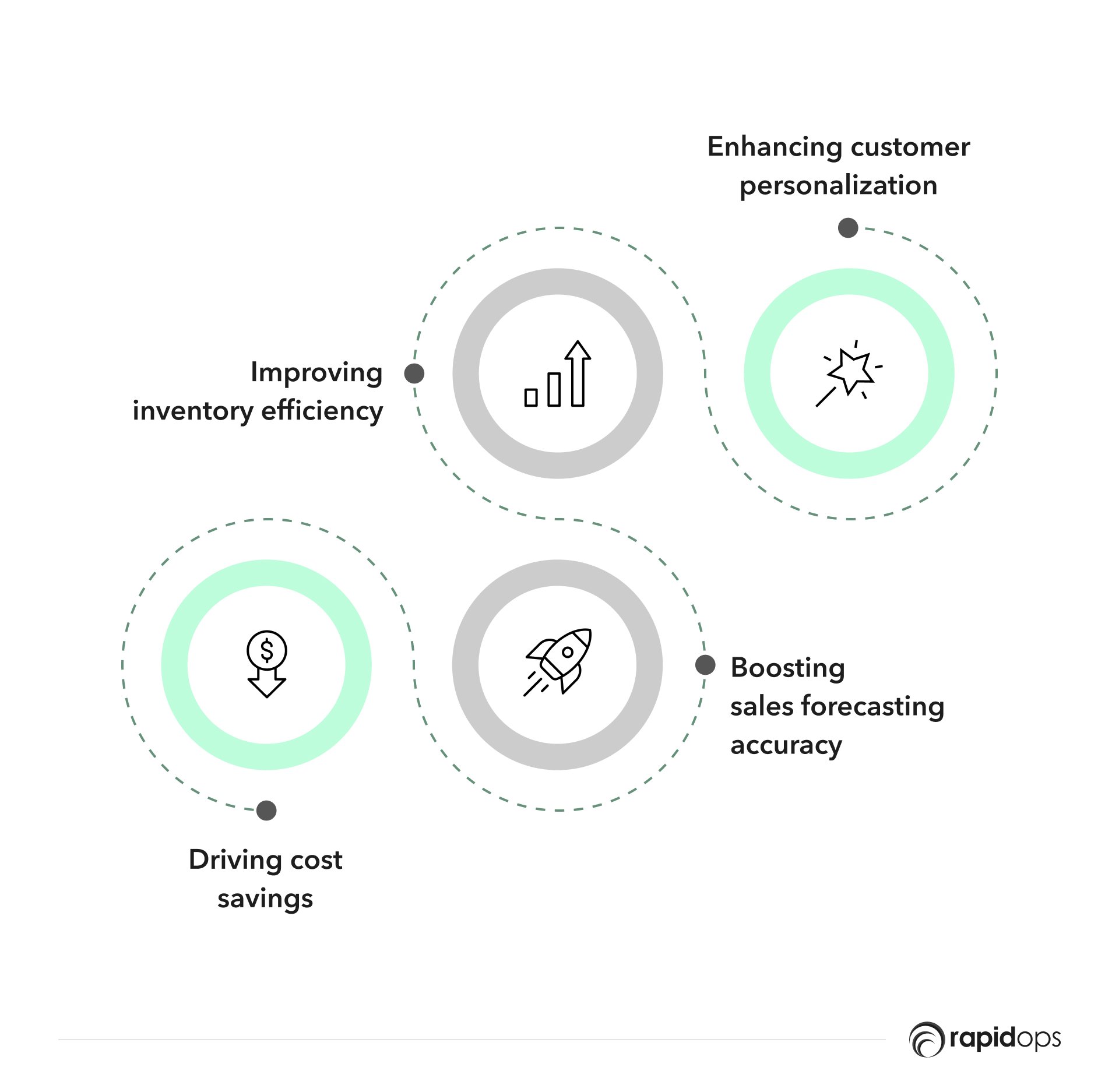
1. Enhancing customer personalization
AI technologies are redefining the retail landscape by enabling unprecedented levels of customer personalization.
AI algorithms offer personalized product recommendations, tailor marketing messages, and create customized shopping experiences that resonate with individual preferences.
And how is this achieved? Through customer data analysis—including purchase history, browsing habits, and social media interactions.
This level of personalization not only enhances their experience but also significantly boosts customer retention and brand loyalty.
Retailers leveraging AI for personalization report increased sales and higher customer engagement rates, as customers are more likely to purchase products that meet their specific needs and interests.
2. Improving inventory efficiency
Seamless inventory management is another area where AI is making a substantial impact.
By utilizing predictive analytics and machine learning, retailers can accurately forecast demand, optimize stock levels, and reduce the risk of overstocking or stockouts.
Automated inventory management systems powered by AI can dynamically adjust orders and distribution based on real-time sales data and external factors such as seasonal trends or market changes.
This results in significant cost savings, reduced waste, and improved operational efficiency, ensuring that retailers can meet customer demand without tying up capital in excess inventory.
3. Boosting sales forecasting accuracy
AI-driven sales forecasting models offer a more accurate prediction of future sales by analyzing various variables, including historical sales data, customer behavior trends, economic indicators, and weather patterns.
This enhanced forecasting ability allows retailers to make informed decisions about product assortments, promotional strategies, and pricing, leading to optimized sales performance and profitability.
Retailers using AI for sales forecasting have seen marked improvements in the accuracy of their predictions, resulting in better stock management and minimized lost sales opportunities.
4. Driving cost savings
AI technologies also contribute to significant cost savings across retail operations.
From automating routine tasks and reducing the need for manual labor to optimizing supply chain logistics and minimizing inventory holding costs, AI enables retailers to operate more efficiently and at a lower cost.
Moreover, AI's ability to improve demand forecasting and inventory management directly impacts the bottom line by reducing markdowns and improving margins.
Retailers adopting AI solutions report not only reduced operational costs but also enhanced competitiveness in the market.
Case study: Enhancing e-commerce experiences through AI for a leading U.S. grocery retailer
A leading U.S. Grocery Retailer embarked on a transformative journey to redefine customer engagement and operational efficiency through Artificial Intelligence (AI) in the fiercely competitive grocery retail sector.
This case study explores the challenges faced by the retailer, the artificial intelligence development services provided by Rapidops, and the significant outcomes achieved, setting new industry standards in personalized shopping experiences.
Objectives
The retailer aimed to leverage AI to overcome several critical challenges:
- Enhance personalization: To deliver tailored product recommendations that align with individual customer preferences and purchasing behaviors, improving the overall shopping experience.
- Improve search functionality: To refine search results and make product discovery more intuitive and effective for users, reducing frustration and dissatisfaction.
- Optimize inventory management: To use predictive analytics for better inventory accuracy, ensuring high-demand products are adequately stocked and available for customers.
AI implementation strategies
Our approach to integrating AI into the retailer's operations involved several innovative strategies:
Personalized product recommendations
We employed advanced algorithms like collaborative and content-based filtering to analyze petabytes of customer and transaction data, including order history and purchasing behavior.
Developing a real-time machine learning engine that delivers personalized upsell and cross-sell suggestions directly to customers through the web or mobile apps.
Curated product listings
Using machine learning algorithms to track onsite behavior and real-time data points, we successfully personalized the recommendations across their 30+ product categories.
We presented products in a way that aligned with customer preferences, including "Most Popular in this Category" and "Trending in this Category" suggestions to boost conversions.
Dynamic search results
We implemented NLP, machine learning, and collaborative filtering to generate tailored search outcomes based on customer queries, browsing behavior, and purchase history.
Enhancing the search experience with smart autocomplete and eliminating zero-result pages to increase engagement and conversion potential.
Inventory predictions
We utilized machine learning to improve inventory predictions based on multiple data sources, including product velocity, seasonality, and supply chain trends.
This allows customers to see low-stock or out-of-stock notifications during their shopping journey, improving order fulfillment rates.
Outcomes
With our AI service initiatives, there were significant improvements across the board for the retailer:
- Increased orders and customer loyalty: The retailer saw a 10% increase in orders and a 1.5x increase in customer loyalty, evidencing the success of personalized shopping experiences.
- Enhanced customer experience: The retailer significantly improved customer satisfaction and engagement by offering curated product listings and dynamic search results.
- Optimized inventory management: The predictive analytics used for inventory management increased accuracy, leading to better product availability and a 5% increase in order rates.
The leading U.S. Grocery Retailer's strategic use of AI has enhanced the e-commerce shopping experience for its customers and optimized operational efficiencies.
By focusing on personalization, intuitive search functionality, and predictive inventory management, the retailer has established a new benchmark for the grocery retail industry.
This case study underscores the transformative potential of AI in retail, offering valuable insights for businesses aiming to leverage technology to meet evolving customer expectations and drive significant business outcomes.
Lessons learned from retail AI implementation
These case studies reveal several key lessons for successful AI implementation in retail:
- Start with clear objectives: Define specific, measurable goals for what you want to achieve with AI.
- Leverage high-quality data: AI's accuracy and effectiveness depend on the data's quality and completeness.
- Focus on better experiences: Use AI to enhance the shopping experience, whether through personalization, inventory management, or efficient operations.
- Adopt a test-and-learn Approach: Pilot AI projects in specific areas before scaling up to ensure the technology meets your business needs.
- Invest in training and change management: Equip your team with the skills to leverage AI technologies and embrace new working methods.
Practical AI applications in retail operations
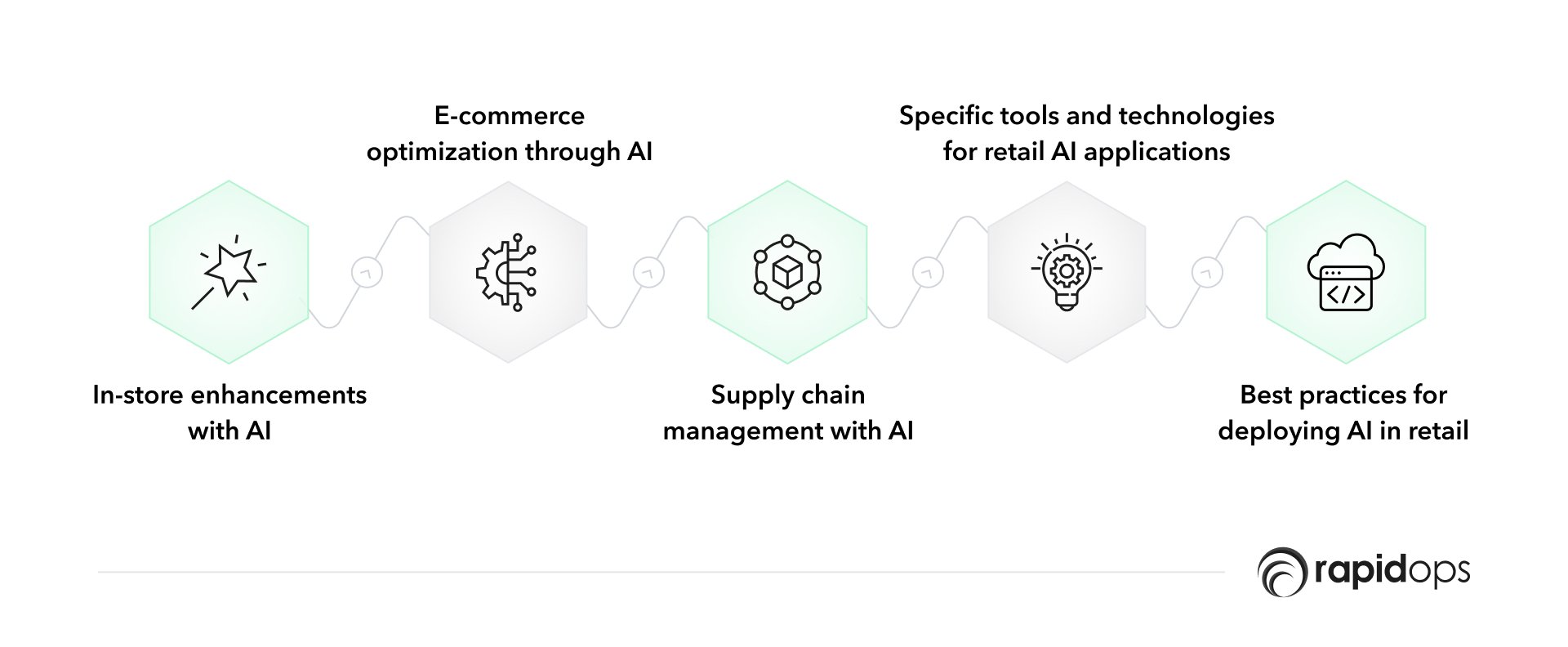
1. In-store enhancements with AI
AI is revolutionizing the in-store experience for both customers and retailers. Smart shelves with weight sensors and RFID tags automatically monitor inventory levels, alerting staff to restocking needs and preventing stockouts in real-time.
Computer vision technology enhances loss prevention strategies by identifying suspicious activities while enabling features like "grab-and-go" shopping, where customers pick up items and are automatically charged without needing traditional checkouts.
These innovations streamline operations and create a more seamless and enjoyable customer shopping experience.
2. E-commerce optimization through AI
AI is crucial in optimizing e-commerce platforms, hands-down!
Personalized recommendations driven by machine learning algorithms analyze a customer's browsing and purchase history to suggest relevant products, significantly boosting conversion rates and average order values.
Chatbots and virtual assistants, powered by natural language processing, provide 24/7 customer service, handling inquiries and guiding customers through purchasing.
This level of personalized engagement ensures a smoother, more intuitive online shopping experience, encouraging repeat visits and loyalty.
3. Supply chain management with AI
AI's impact extends deep into the supply chain, offering predictive insights that enable more efficient operations. Predictive analytics accurately forecast demand, allowing retailers to optimize their inventory and reduce costs associated with overstocking or understocking.
AI-driven logistics solutions automate and optimize routing, deliveries, and returns, ensuring products are moved most efficiently. This cuts costs and reduces environmental impact, aligning with sustainability goals.
4. Specific tools and technologies for retail AI applications
Retailers are turning to various tools and technologies to implement these AI applications.
Machine learning platforms like TensorFlow and PyTorch enable the development of custom AI models for predictive analytics and personalization.
Cloud-based AI services from AWS, Google Cloud, and Microsoft Azure offer scalable, on-demand resources for processing and analyzing large datasets. OpenCV provides a robust foundation for developing automated monitoring and customer interaction features for computer vision applications.
Integrating these technologies requires a strategic approach, focusing on scalability, data privacy, and seamless integration with existing retail systems.
5. Best practices for deploying AI in retail
- Start small and scale: Begin with pilot projects to demonstrate value before rolling out AI across the organization.
- Ensure data privacy and security: With the increased use of customer data, maintaining privacy and security is paramount. Adhere to regulations and best practices to protect sensitive information.
- Invest in training: Equip your team with the necessary skills to effectively leverage AI tools and interpret insights.
- Measure and iterate: Continuously monitor the performance of AI initiatives against key metrics and be prepared to iterate and improve based on feedback and results.
Navigating AI implementation challenges in retail
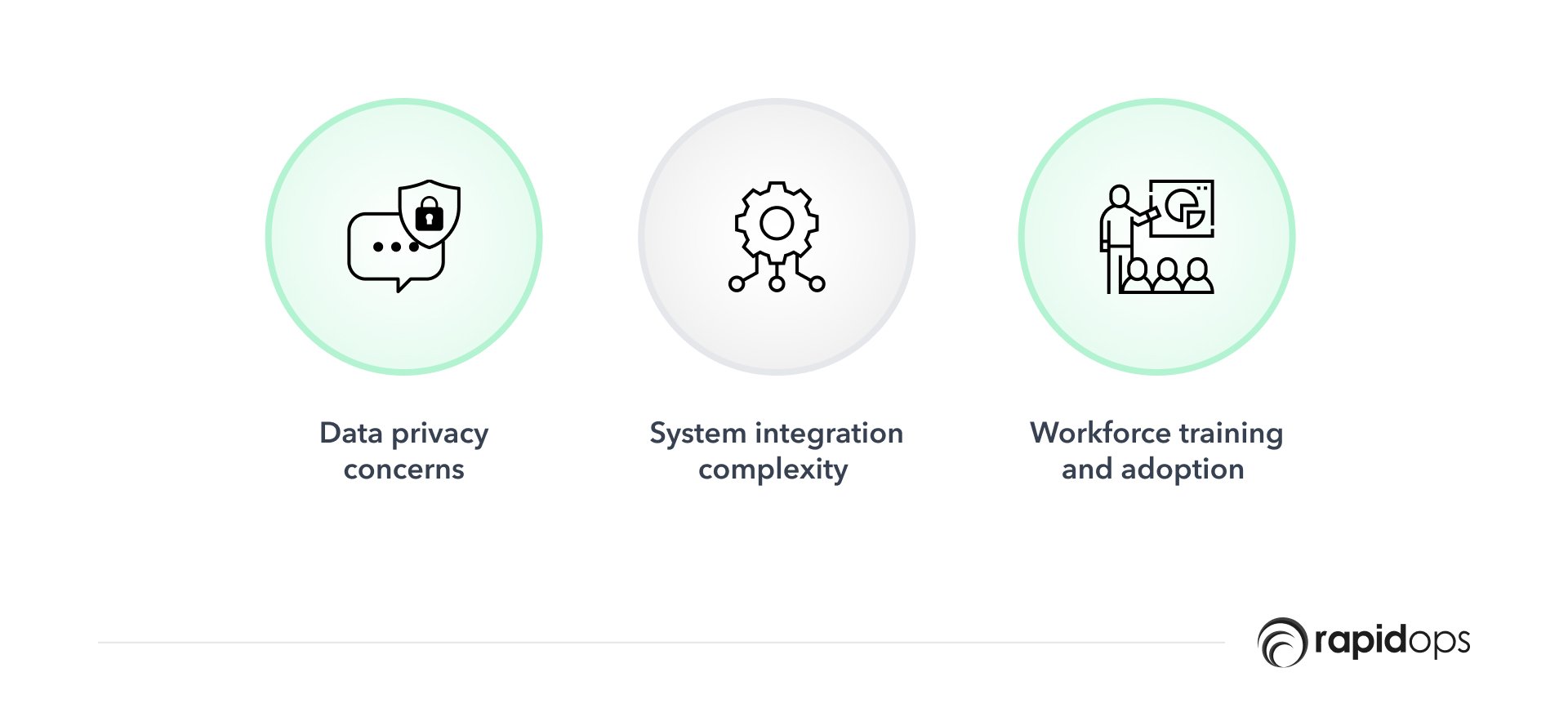
Implementing AI in retail offers transformative potential but comes with challenges. Addressing these effectively is crucial for retailers to harness AI technologies' benefits fully.
1. Data privacy concerns
With AI relying heavily on customer data for personalization and insights, data privacy emerges as a primary concern. Retailers must navigate complex regulatory landscapes like GDPR in Europe and CCPA in California, ensuring compliance while still leveraging data for AI applications.
Solution: Implement robust data governance policies and practices. Anonymize and encrypt sensitive customer data to protect privacy. Transparency with customers about their data use and offering opt-out options can also build trust.
2. System integration complexity
Integrating AI technologies with existing retail systems can be complex and resource-intensive. Legacy systems may not be readily compatible with new AI tools, leading to integration challenges.
Solution: Adopt a phased approach to integration, starting with areas where AI can provide quick wins. Use API-based integration platforms to connect AI applications with existing systems more smoothly. Consider partnering with technology providers that offer integration support.
3. Workforce training and adoption
Adopting AI requires a shift in skill sets and mindsets among the retail workforce. Employees may need training to work alongside AI technologies, and there might be resistance to change.
Solution: Invest in comprehensive training programs to upskill employees, focusing on how AI can augment their roles rather than replace them. Engage employees early in the AI implementation process to proactively gain buy-in and address concerns.
4. Expert insights on best practices
Industry experts emphasize the importance of a strategic, informed approach to AI adoption. Key advice includes focusing on clear business objectives, ensuring executive buy-in, and adopting a customer-centric perspective in AI initiatives. Experts also recommend continuous monitoring and iteration of AI projects to adapt to changing market conditions and technological advancements.
An actionable framework for AI adoption in retail
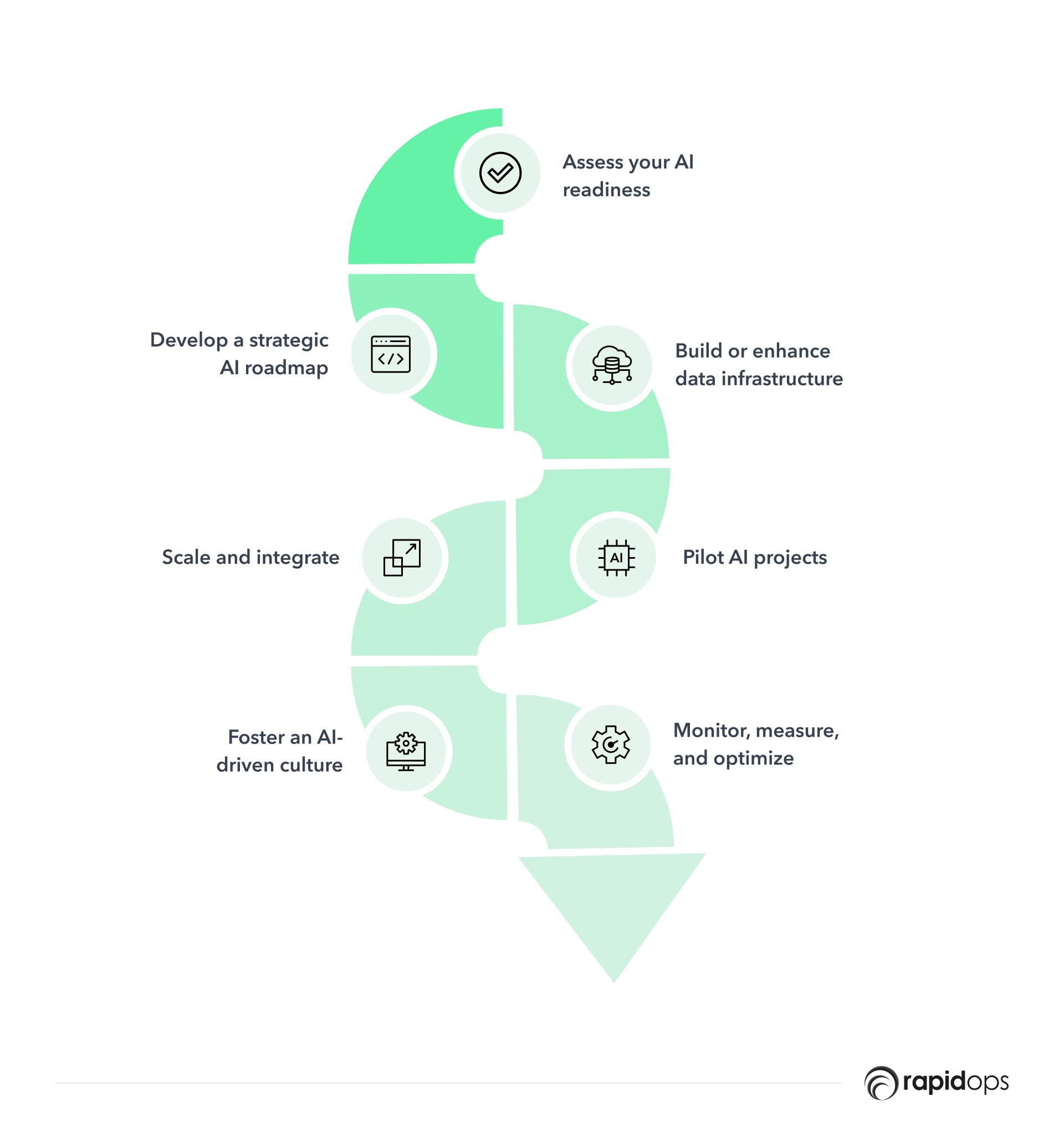
Adopting AI in retail requires a structured approach to ensure success and maximize ROI. Here's a step-by-step guide tailored for retail businesses at different stages of AI adoption.
1. Assess your AI readiness
- Evaluate current capabilities: Assess your existing technology infrastructure, data quality, and analytics capabilities to determine your readiness for AI.
- Define business objectives: Identify what you aim to achieve with AI, whether it's improving your audience's experience, optimizing inventory, or enhancing sales forecasting.
2. Develop a strategic AI roadmap
- Prioritize use cases: Based on your business objectives, prioritize AI use cases that align with your strategic goals and offer the highest potential value.
- Allocate resources: Determine the budget, personnel, and time required for AI projects. Consider potential ROI to justify investments.
3. Build or enhance data infrastructure
- Ensure data quality: Cleanse and consolidate data sources to ensure high-quality data for AI algorithms.
- Invest in technology: If necessary, upgrade your technology infrastructure to support AI, including cloud storage, data processing capabilities, and security measures.
4. Pilot AI projects
- Start small: Select a high-priority use case to pilot, allowing you to test AI solutions on a small scale before wider deployment.
- Measure success: Define clear metrics for success and monitor the pilot closely to evaluate performance against these metrics.
5. Scale and integrate
- Learn and iterate: Use insights and feedback from the pilot phase to refine AI solutions. Address any challenges encountered during the pilot before scaling.
- Scale confidently: Gradually scale AI solutions across the organization, integrating them into existing systems and processes.
6. Foster an AI-driven culture
- Train employees: Provide training and resources to help employees understand and embrace AI tools. Highlight how AI can augment their work and drive business value.
- Promote collaboration: Encourage collaboration between technology teams and business units to ensure AI initiatives are aligned with business goals and customer needs.
7. Monitor, measure, and optimize
- Continuous monitoring: Establish processes for ongoing monitoring of AI systems to ensure they perform as expected and promptly identify any issues.
- Iterative improvement: Regularly review AI initiatives against business objectives and market developments. Be prepared to adapt and refine AI strategies as needed.
Key considerations for AI adoption
- Align AI with business objectives: Ensure every AI initiative is linked to strategic business goals.
- Focus on customer experience: Prioritize AI projects that enhance the customer experience, as these will likely deliver significant value.
- Adopt a data-driven mindset: Cultivate a culture that values data-driven decision-making, leveraging AI insights to inform business strategies.
Essential technology stack for retail AI implementation
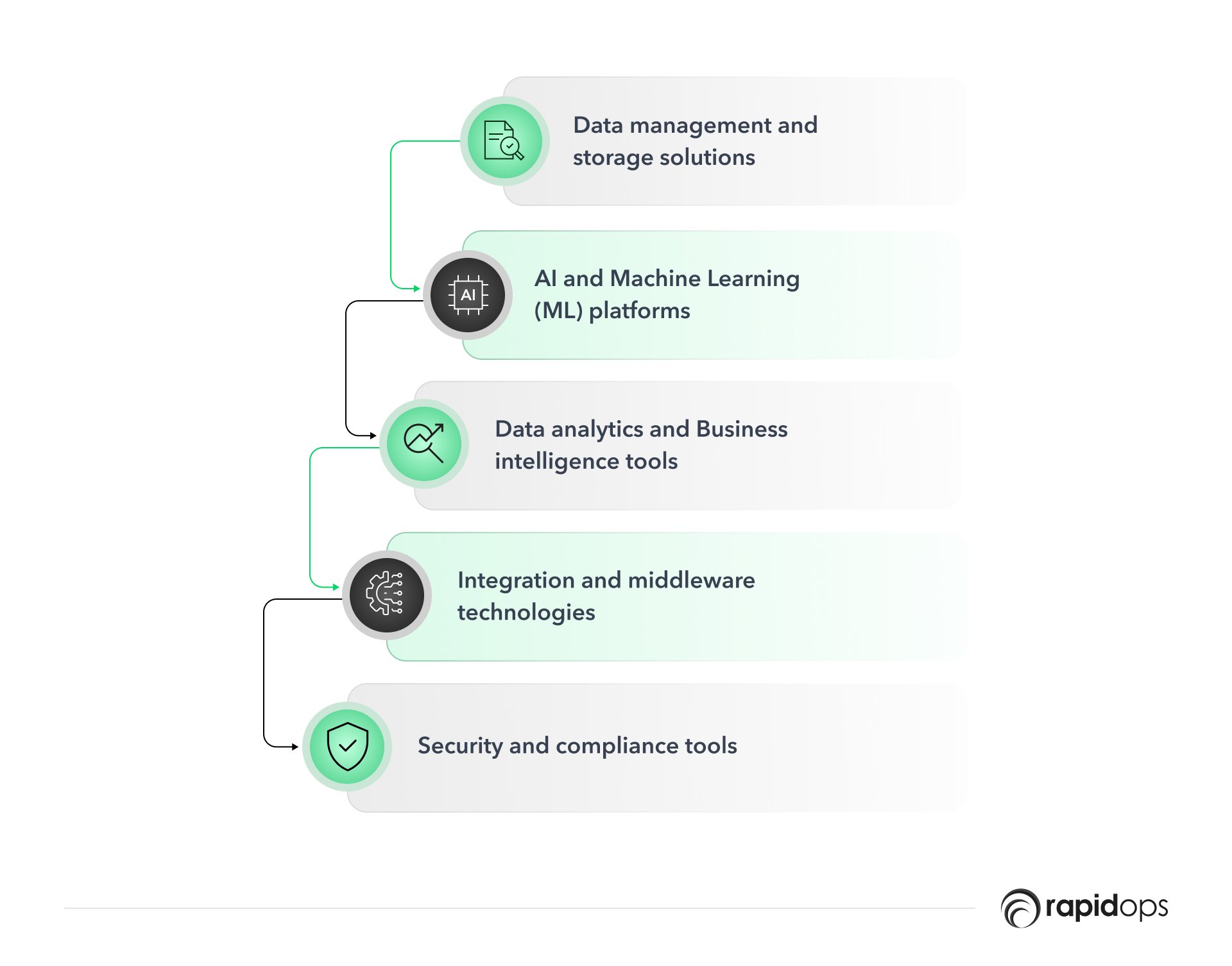
Selecting the right technology stack is crucial for retailers embarking on their AI journey. This stack supports AI capabilities and ensures scalability and seamless integration with existing systems. Here's a breakdown of the essential components of a technology stack for AI in retail.
1. Data management and storage solutions
- Cloud storage platforms: AWS S3, Google Cloud Storage, and Microsoft Azure Blob Storage offer scalable, secure, and cost-effective solutions for storing vast data.
- Data lakes and warehouses: Technologies like Amazon Redshift, Google BigQuery, and Snowflake are critical for aggregating, storing, and analyzing data from diverse sources in a centralized repository.
2. AI and Machine Learning (ML) platforms
- Machine learning frameworks: TensorFlow, PyTorch, and Scikit-learn provide the foundation for developing and training custom AI models tailored to retail needs.
- AI services: Cloud-based AI services from AWS, Google Cloud AI, and Azure AI offer pre-built models for various applications, including language understanding, speech recognition, and visual search, facilitating rapid deployment of AI features.
3. Data analytics and business intelligence tools
- Analytics platforms: Tools like Tableau, Power BI, and Looker help retailers visualize data insights, making it easier to understand customer behaviors, sales trends, and operational inefficiencies.
- Big data processing: Apache Spark and Hadoop enable efficient processing of large datasets, crucial for real-time analytics and predictive modeling.
4. Integration and middleware technologies
- API management tools: MuleSoft, Apigee, and AWS API Gateway are essential for creating, managing, and securing APIs, enabling seamless integration of AI applications with existing retail systems.
- Event stream processing: Kafka and AWS Kinesis support real-time data processing, which is crucial for applications that rely on up-to-the-minute data, such as dynamic pricing and inventory management.
5. Security and compliance tools
- Data encryption and masking: Tools to protect sensitive customer and business data, ensuring compliance with data protection regulations.
- Identity and access management (IAM): Solutions like Okta, AWS IAM, and Azure Active Directory manage user identities and permissions, safeguarding access to data and applications.
Criteria for selecting technology partners
When choosing technology partners and solutions, retailers should consider the following:
- Scalability: Can the technology scale meet growing data and processing needs?
- Compatibility: How well does the solution integrate with existing retail systems and workflows?
- Expertise and support: Does the vendor offer robust technical support and expertise in retail applications?
- Security and compliance: Does the solution comply with relevant data protection regulations and offer strong security features?
- Cost-effectiveness: Does the solution offer a good ROI considering upfront and ongoing costs?
Selecting the right technology stack and partners is a strategic decision that can significantly impact the success of AI initiatives in the retail ecosystem. It requires balancing current needs and future growth, ensuring retailers can leverage AI to drive innovation and gain a competitive advantage.
Preparing for the future of AI in retail
As the retail industry evolves rapidly, staying ahead of the curve with AI technology becomes crucial for retailers seeking to maintain a competitive edge. Here's a look at emerging AI trends and how retailers can strategically adapt to the future landscape.
1. Emerging AI trends in retail
- Augmented Reality (AR) and Virtual Reality (VR): These technologies are set to transform the online and in-store shopping experience, allowing customers to visualize products in real-life settings or navigate virtual fitting rooms.
- AI-powered voice assistants: Beyond simple voice commands, future voice assistants will offer more personalized shopping experiences, making recommendations based on customer preferences and past purchases.
- Autonomous delivery vehicles and drones: As logistics and delivery processes become more automated, retailers will leverage these technologies for faster, more cost-effective delivery solutions.
- Blockchain for supply chain transparency: Integrating AI with blockchain technology will provide unmatched transparency in supply chains, enabling consumers to trace product origins and ensure authenticity.
- Predictive and prescriptive analytics: Advanced analytics will move beyond forecasting to offer prescriptive insights, suggesting actions retailers can take to optimize operations and enhance customer experiences.
2. Strategic advice for adapting to AI advancements
- Invest in continuous learning: Retailers must stay informed about technological advancements and market trends. Investing in continuous learning and development for team members ensures that your business remains agile and can quickly adopt new technologies.
- Foster a culture of innovation: Create an environment where experimentation with new technologies is encouraged. Pilot projects and innovation labs can help explore the potential of emerging AI applications without the pressure of immediate ROI.
- Leverage data strategically: As AI technologies become more sophisticated, the value of data as a strategic asset increases. Retailers should enhance data collection, processing, and analysis capabilities to leverage AI innovations fully.
- Partner with tech innovators: Collaborating with startups and technology innovators can provide early access to new AI solutions. These partnerships can offer fresh perspectives and expertise that complement your in-house capabilities.
- Prepare for ethical and regulatory challenges: As AI becomes more integral to retail, ethical considerations and regulatory compliance will become increasingly complex. Retailers must proactively address these issues, ensuring ethical use of AI and adherence to evolving regulations.
3. The role of innovation in staying ahead
Innovation is not just about adopting new technologies; it's about reimagining retail operations and customer experiences in digital transformation.
Retailers that embrace AI not as a set of tools but as a driver of strategic innovation will be best positioned to thrive in the future marketplace.
By anticipating changes, investing in the right technologies, and fostering a culture that values adaptation and learning, retailers can confidently navigate the evolving landscape of AI.
The future of retail lies in harnessing the power of AI to create more personalized, efficient, and engaging shopping experiences, and the time to prepare is now.
Conclusion: Embracing AI for a competitive edge in retail
The journey through the transformative potential of Artificial Intelligence in the retail sector underscores a clear message: AI is not just a technological upgrade.
It's a strategic imperative for businesses seeking to thrive in an increasingly competitive and dynamic marketplace.
From enhancing customer personalization and optimizing inventory efficiency to boosting sales forecasting accuracy and driving cost savings, AI's benefits in retail are vast and compelling.
Accelerate your AI journey
The time to act for retailers yet to embark on their AI journey is now.
The insights and strategies outlined in this article offer a roadmap for leveraging AI to meet and exceed consumers' demands, creating unparalleled shopping experiences that foster loyalty and drive growth.
For those already on the path to AI adoption, the call is to accelerate, innovate, and scale the solutions that have shown promise.
- Start with a clear vision: Define your aim with AI, aligning technology adoption with your business objectives and customer needs.
- Build on solid foundations: Ensure your data infrastructure and technology stack can support AI initiatives, focusing on scalability, integration, and security.
- Foster a culture ready for change: Prepare your organization for AI adoption by investing in training, promoting a culture of innovation, and adapting leadership and operational practices to support digital transformation.
- Engage with the right partners: Collaborate with technology providers, industry experts, and innovation hubs to gain access to the latest AI tools, insights, and best practices.
Embrace AI with confidence
The future of retail belongs to those who are prepared to embrace AI and harness its full potential.
By focusing on strategic implementation, continuous improvement, and customer-centric innovation, retailers can not only navigate the challenges of today's retail environment but also shape the industry's future.
Let this be your moment to redefine what's possible in retail. The transformative journey of AI in retail is just beginning, and by acting on the insights provided, you can secure a leading position in this exciting future.
Frequently asked questions about AI in retail
How can retailers ensure data privacy when adopting AI?
Where should retailers start with AI adoption?
What are the key challenges retailers face in implementing AI?
How does AI contribute to creating a personalized shopping experience?
Can AI improve supply chain management in retail?
What role does AI play in enhancing in-store experiences?
What’s Inside
- What is artificial intelligence in the retail industry?
- Addressing retail needs with AI
- AI use cases in the retail industry
- How does AI benefit retail?
- Case study: Enhancing e-commerce experiences through AI for a leading U.S. grocery retailer
- Practical AI applications in retail operations
- Navigating AI implementation challenges in retail
- An actionable framework for AI adoption in retail
- Essential technology stack for retail AI implementation
- Criteria for selecting technology partners
- Preparing for the future of AI in retail
- Conclusion: Embracing AI for a competitive edge in retail

